Ancient Greek technology

Ancient Greek technology developed during the 5th century BC, continuing up to and including the Roman period, and beyond. Inventions that are credited to the ancient Greeks include the gear, screw, rotary mills, screw press, bronze casting techniques, water clock, water organ, torsion catapult, the use of steam to operate some experimental machines and toys, and a chart to find prime numbers. Many of these inventions occurred late in the Greek period, often inspired by the need to improve weapons and tactics in war. However, peaceful uses are shown by their early development of the watermill, a device which pointed to further exploitation on a large scale under the Romans. They developed surveying and mathematics to an advanced state, and many of their technical advances were published by philosophers, like Archimedes and Heron.
Water technology
Some fields that were encompassed in the area of water resources (mainly for urban use) included groundwater exploitation, construction of aqueducts for water supply, stormwater and wastewater sewerage systems, flood protection and drainage, construction and use of fountains, baths and other sanitary and purgatory facilities, and even recreational uses of water.[5]
Mining
The Greeks developed extensive silver mines at Laurium, the profits from which helped support the growth of Athens as a city-state. It involved mining the ore in underground galleries, washing it and smelting it to produce the metal. Elaborate washing tables still exist at the site, which used rain water held in cisterns and collected during the winter months. Mining also helped to create currency by the conversion of the metal into coinage.
Technology
The failure of the Greeks to develop their technology has sometimes been attributed to the low status of people providing labor. Manual labor was despised, and anyone applying science to it was likely to lose status in society, removing much of the incentive to seek technological innovation. A sophisticated tunnel built for an aqueduct in the 6th century BC by the engineer Eupalinos at Samos has led to some reevaluation of the skills of the Greeks.
| Technology | Date | Description | |
|---|---|---|---|
| Archimedes Screw | c. 3rd century BC | This device, capable of lifting solid or liquid substances from a lower plane to a higher elevation, is traditionally attributed to the Greek mathematician Archimedes of Syracuse.[6][7] | 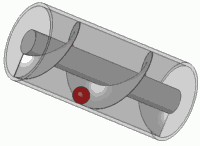 |
| Streets | c. 400 BC | Example: The Porta Rosa (4th–3rd century BC) was the main street of Elea (Italy) and connected the northern quarter to the southern quarter. The street is 5 meters wide. At its steepest, it has an inclination of 18%. It is paved with limestone blocks, griders cut in square blocks, and on one side a small gutter for the drainage of rain water. The building is dated during the time of the reorganization of the city during Hellenistic age. (4th to 3rd centuries BC) | |
| Cartography | c. 600 BC | First widespread amalgamation of geographical maps developed by Anaximander, although it is possible he had been exposed to mapmaking practices of the Near East.[8] | |
| Rutway | c. 600 BC | The 6 to 8.5 km long Diolkos represented a rudimentary form of railway.[9] | 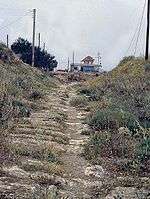 |
| Differential gears | c. 100-70 BC | The Antikythera mechanism, from the Roman-era Antikythera wreck, employed a differential gear to determine the angle between the ecliptic positions of the sun and moon, and thus the phase of the moon.[10][11] |  |
| Caliper | 6th century BC | Earliest example found in the Giglio wreck near the Italian coast. The wooden piece already featured one fixed and a movable jaw.[12][13] | |
| Truss roof | 550 BC[14] | See List of Greco-Roman roofs | |
| Crane | c. 515 BC | Labor-saving device that allowed the employment of small and efficient work teams on construction sites. Later winches were added for heavy weights.[15] | 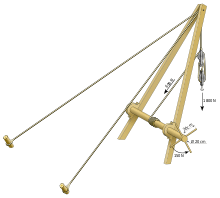 |
| Escapement | 3rd century BC | Described by the Greek engineer Philo of Byzantium (3rd century BC) in his technical treatise Pneumatics (chapter 31) as part of a washstand automaton for guests washing their hands. Philon's comment that "its construction is similar to that of clocks" indicates that such escapement mechanisms were already integrated in ancient water clocks.[16] | 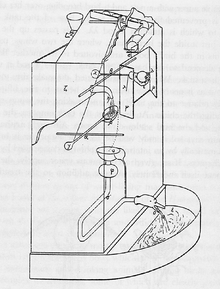 |
| Tumbler lock | c. 5th century BC | The tumbler lock, as well as other varieties of lock, was introduced in Greece in the 5th century BC. | |
| Gears | c. 5th century BC | Developed further than in prehistoric times for a variety of practical purposes. | |
| Plumbing | c. 5th century BC | Although there is evidence for Sanitation of the Indus Valley Civilisation, the ancient Greek civilization of Crete, known as the Minoan civilization, was the first civilization to use underground clay pipes for sanitation and water supply.[17] Excavations at Olympus, as well as Athens, have revealed extensive plumbing systems for baths, fountains, and personal use. | |
| Spiral staircase | 480–470 BC | The earliest spiral staircases appear in Temple A in Selinunte, Sicily, to both sides of the cella. The temple was constructed around 480–470 BC.[18] | 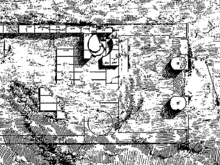 |
| Urban planning | c. 5th century BC | Miletus is one of the first known towns in the world to have a grid-like plan for residential and public areas. It accomplished this feat through a variety of related innovations in areas such as surveying. | |
| Winch | 5th century BC | The earliest literary reference to a winch can be found in the account of Herodotus of Halicarnassus on the Persian Wars (Histories 7.36), where he describes how wooden winches were used to tighten the cables for a pontoon bridge across the Hellespont in 480 BC. Winches may have been employed even earlier in Assyria, though. By the 4th century BC, winch and pulley hoists were regarded by Aristotle as common for architectural use (Mech. 18; 853b10-13).[19] | |
| Showers | 4th century BC | A shower room for female athletes with plumbed-in water is depicted on an Athenian vase. A whole complex of shower-baths was also found in a 2nd-century BC gymnasium at Pergamum.[20] | |
| Central heating | c. 350 BC | Great Temple of Ephesus was warmed by heated air that was circulated through flues laid in the floor. | |
| Lead sheathing | c. 350 BC | To protect a ship's hull from boring creatures; see Kyrenia ship | |
| Astrolabe | c. 300 BC | First used around 200 BC by astronomers in Greece. Used to determine the altitude of objects in the sky.[21][22] | |
| Canal lock | early 3rd century BC | Built into Ancient Suez Canal under Ptolemy II (283–246 BC).[23][24][25] | |
| Ancient Suez Canal | early 3rd century BC | Opened by Greek engineers under Ptolemy II (283–246 BC), following earlier, probably only partly successful attempts.[26] | |
| Lighthouse | c. 3rd century BC | According to Homeric legend, Palamidis of Nafplio invented the first lighthouse, although they are certainly attested with the Lighthouse of Alexandria (designed and constructed by Sostratus of Cnidus) and the Colossus of Rhodes. However, Themistocles had earlier established a lighthouse at the harbor of Piraeus connected to Athens in the 5th century BC, essentially a small stone column with a fire beacon.[27] | 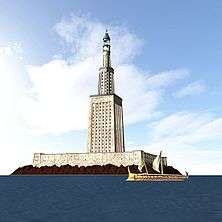 |
| Water wheel | 3rd century BC | First described by Philo of Byzantium (c. 280–220 BC).[28] | |
| Alarm clock | 3rd century BC | The Hellenistic engineer and inventor Ctesibius (fl. 285–222 BC) fitted his clepsydras with a dial and pointer for indicating the time, and added elaborate "alarm systems, which could be made to drop pebbles on a gong, or blow trumpets (by forcing bell-jars down into water and taking the compressed air through a beating reed) at pre-set times" (Vitruv 11.11).[29] | |
| Odometer | c. 3rd century BC | Odometer, a device used in the late Hellenistic time and by Romans for indicating the distance travelled by a vehicle. It was invented sometime in the 3rd century BC. Some historians attribute it to Archimedes, others to Heron of Alexandria. It helped revolutionize the building of roads and travelling by them by accurately measuring distance and being able to carefully illustrate this with a milestone. | |
| Chain drive | 3rd century BC | First described by Philo of Byzantium, the device powered a repeating crossbow, the first known of its kind.[30] | |
| Cannon | c. 3rd century BC | Ctesibius of Alexandria invented a primitive form of the cannon, operated by compressed air. | |
| Double-action principle | 3rd century BC | Universal mechanical principle that was discovered and first applied by the engineer Ctesibius in his double action piston pump, which was later developed further by Heron to a fire hose (see below).[31] | |
| Levers | c. 260 BC | First described about 260 BC by the ancient Greek mathematician Archimedes. Although used in prehistoric times, they were first put to practical use for more developed technologies in Ancient Greece.[32] | |
| Water mill | c. 250 BC | The use of water power was pioneered by the Greeks: The earliest mention of a water mill in history occurs in Philo's Pneumatics, previously been regarded as a later Arabic interpolation, but according to recent research to be of authentic Greek origin.[1][33] | |
| Three-masted ship (mizzen) | c. 240 BC: | First recorded for Syracusia as well as other Syracusan (merchant) ships under Hiero II of Syracuse[34] | |
| Gimbal | 3rd century BC | The inventor Philo of Byzantium (280–220 BC) described an eight-sided ink pot with an opening on each side, which can be turned so that any face is on top, dip in a pen and ink it-yet the ink never runs out through the holes of the side. This was done by the suspension of the inkwell at the center, which was mounted on a series of concentric metal rings which remained stationary no matter which way the pot turns itself.[35] |  |
| Fore-and-aft rig (spritsail) | 2nd century BC | Spritsails, the earliest fore-and-aft rigs, appeared in the 2nd century BC in the Aegean Sea on small Greek craft.[36] | 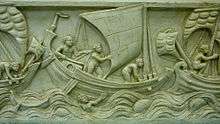 |
| Air and water pumps | c. 2nd century BC | Ctesibius and various other Greeks of Alexandria of the period developed and put to practical use various air and water pumps which served a variety of purposes,[37] such as a water organ and, by the 1st century AD, Heron's fountain. | |
| Sakia gear | 2nd century BC | First appeared in 2nd-BC Hellenistic Egypt, where pictorial evidence already showed it fully developed[38] | |
| Surveying tools | c. 2nd century BC | Various records relating to mentions of surveying tools have been discovered, mostly in Alexandrian sources, these greatly helped the development of the precision of Roman aqueducts. | |
| Analog computers | c. 150 BC | In 1900–1901, the Antikythera mechanism was found in the Antikythera wreck. It is thought that this device was an analog computer designed to calculate astronomical positions and was used to predict lunar and solar eclipses based on Babylonian arithmetic-progression cycles. Whereas the Antikythera mechanism is considered a proper analog computer, the astrolabe (also invented by the Greeks) may be considered as a forerunner.[39] | 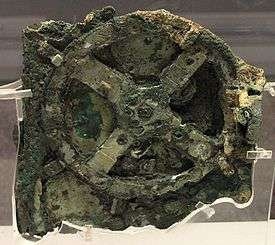 |
| Fire hose | 1st century BC | Invented by Heron in the basis of Ctesibius' double action piston pump.[31] Allowed for more efficient fire fighting. | |
| Vending machine | 1st century BC | The first vending machine was described by Heron of Alexandria. His machine accepted a coin and then dispensed a fixed amount of holy water. When the coin was deposited, it fell upon a pan attached to a lever. The lever opened up a valve, which let some water flow out. The pan continued to tilt with the weight of the coin until it fell off, at which point a counter-weight would snap the lever back up and turn off the valve.[31] | |
| Wind vane | 50 BC | The Tower of the Winds on the Roman agora in Athens featured atop a wind vane in the form of a bronze Triton holding a rod in his outstretched hand rotating to the wind blowing. Below, its frieze was adorned with the eight wind deities. The 8 m high structure also featured sundials and a water clock inside dates from around 50 BC.[40] | |
| Clock tower | 50 BC | See Clock tower.[41] | 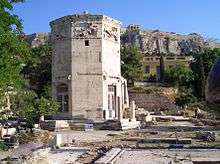 |
| Automatic doors | c. 1st century AD | Heron of Alexandria, a 1st-century BC inventor from Alexandria, Egypt, created schematics for automatic doors to be used in a temple with the aid of steam power.[31] |
See also
- Roman technology
- History of science in Classical Antiquity
- Medieval technology
- Science in Medieval Western Europe
- List of Byzantine inventions
References
- 1 2 3 Wilson, Andrew (2002). "Machines, Power and the Ancient Economy". The Journal of Roman Studies. 92: 1–32 (7f.). doi:10.1017/s0075435800032135. JSTOR 3184857.
- ↑ Wikander, Örjan (1985). "Archaeological Evidence for Early Water-Mills. An Interim Report". History of Technology. 10: 151–179 (160).
- ↑ Wikander, Örjan (2000). "The Water-Mill". Handbook of Ancient Water Technology. Technology and Change in History. 2. Leiden: Brill. pp. 371–400 (396f.). ISBN 90-04-11123-9.
- ↑ Donners, K.; Waelkens, M.; Deckers, J. (2002). "Water Mills in the Area of Sagalassos: A Disappearing Ancient Technology". Anatolian Studies. 52: 1–17 (11). doi:10.2307/3643076. JSTOR 3643076.
- ↑ Angelakis, A. N.; Koutsoyiannis, D. (2003). "Urban water engineering and management in ancient Greece". In Stewart, B. A.; Howell, T. The Encyclopedia of Water Science. New York: Dekker. pp. 999–1007. ISBN 0-8247-0948-9.
- ↑ Oleson, John Peter (2000), "Water-Lifting", in Wikander, Örjan, Handbook of Ancient Water Technology, Technology and Change in History, 2, Leiden, pp. 217–302 (242–251), ISBN 90-04-11123-9
- ↑ David Sacks (2005) [1995]. Oswin Murray and Lisa R. Brody (eds), Encyclopedia of the Ancient Greek World. Revised Edition. New York: Facts on File. ISBN 0-8160-5722-2, pp 303-304.
- ↑ Alex C. Purves (2010). Space and Time in Ancient Greek Narrative. Cambridge & New York: Cambridge University Press. ISBN 978-0-521-19098-5, pp 98-99.
- ↑ Lewis, M. J. T. (2001) "Railways in the Greek and Roman world" Archived July 21, 2011, at the Wayback Machine., in Guy, A. / Rees, J. (eds), Early Railways. A Selection of Papers from the First International Early Railways Conference, pp. 8–19 (8 & 15), ISBN 090468508X.
- ↑ Wright, M. T. (2007). "The Antikythera Mechanism reconsidered" (PDF). Interdisciplinary science reviews. 32 (1). Retrieved 20 May 2014.
- ↑ Bernd Ulmann (2013). Analog Computing. Munich: Oldenbourg Verlag München. ISBN 978-3-486-72897-2, p. 6.
- ↑ Bound, Mensun (1991) The Giglio wreck: a wreck of the Archaic period (c. 600 BC) off the Tuscan island of Giglio, Hellenic Institute of Marine Archaeology, Athens.
- ↑ Ulrich, Roger B. (2007) Roman woodworking, Yale University Press, New Haven, Conn., pp. 52f., ISBN 0-300-10341-7.
- ↑ Hodge, A. Trevor Paul (1960) The Woodwork of Greek Roofs, Cambridge University Press, p. 41.
- ↑ Coulton, J. J. (1974), "Lifting in Early Greek Architecture", The Journal of Hellenic Studies, 94: 1–19 (7), doi:10.2307/630416, JSTOR 630416
- ↑ Lewis, Michael (2000). "Theoretical Hydraulics, Automata, and Water Clocks". In Wikander, Örjan. Handbook of Ancient Water Technology. Technology and Change in History. 2. Leiden. pp. 343–369 (356f.). ISBN 90-04-11123-9.
- ↑ "The History of Plumbing - CRETE". theplumber.com. theplumber.com. Retrieved 26 March 2014.
- ↑ Ruggeri, Stefania : „Selinunt“, Edizioni Affinità Elettive, Messina 2006 ISBN 88-8405-079-0, p.77
- ↑ Coulton, J. J. (1974). "Lifting in Early Greek Architecture". The Journal of Hellenic Studies. 94: 1–19 (12). doi:10.2307/630416. JSTOR 630416.
- ↑ Ancient Inventions: Showers. inventions.org
- ↑ Evans, James (1998), The History and Practice of Ancient Astronomy, Oxford University Press, ISBN 0-19-509539-1, p. 155.
- ↑ Krebs, Robert E.; Krebs, Carolyn A. (2003), Groundbreaking Scientific Experiments, Inventions, and Discoveries of the Ancient World, Greenwood Press, p. 56.
- ↑ Moore, Frank Gardner (1950). "Three Canal Projects, Roman and Byzantine". American Journal of Archaeology. 54 (2): 97–111 (99–101). doi:10.2307/500198.
- ↑ Froriep, Siegfried (1986): "Ein Wasserweg in Bithynien. Bemühungen der Römer, Byzantiner und Osmanen", Antike Welt, 2nd Special Edition, pp. 39–50 (46)
- ↑ Schörner, Hadwiga (2000): "Künstliche Schiffahrtskanäle in der Antike. Der sogenannte antike Suez-Kanal", Skyllis, Vol. 3, No. 1, pp. 28–43 (33–35, 39)
- ↑ Schörner, Hadwiga (2000): "Künstliche Schiffahrtskanäle in der Antike. Der sogenannte antike Suez-Kanal", Skyllis, Vol. 3, No. 1, pp. 28–43 (29–36)
- ↑ Elinor Dewire and Dolores Reyes-Pergioudakis (2010). The Lighthouses of Greece. Sarasota: Pineapple Press. ISBN 978-1-56164-452-0, pp 1-5.
- ↑ Oleson, John Peter (2000): "Water-Lifting", in: Wikander, Örjan: "Handbook of Ancient Water Technology", Technology and Change in History, Vol. 2, Brill, Leiden, ISBN 90-04-11123-9, pp. 217–302 (233)
- ↑ Landels, John G. (1979). "Water-Clocks and Time Measurement in Classical Antiquity". Endeavour. 3 (1): 32–37 [35]. doi:10.1016/0160-9327(79)90007-3.
- ↑ Werner Soedel, Vernard Foley: Ancient Catapults, Scientific American, Vol. 240, No. 3 (March 1979), p.124-125
- 1 2 3 4 Jaffe, Eric (December 2006) Old World, High Tech: World's First Vending Machine. Smithsonian magazine.
- ↑ Usher, A. P. (1929). A History of Mechanical Inventions. Harvard University Press (reprinted by Dover Publications 1988). p. 94. ISBN 978-0-486-14359-0. OCLC 514178. Retrieved 7 April 2013.
- ↑ Lewis, M. J. T. (1997) Millstone and Hammer: the origins of water power, University of Hull Press, pp. 1–73 especially 44–45 and 58–60, ISBN 085958657X.
- ↑ Casson, Lionel (1995): "Ships and Seamanship in the Ancient World", Johns Hopkins University Press, pp. 242, fn. 75, ISBN 978-0-8018-5130-8.
- ↑ Sarton, G. (1970) A History of Science, The Norton Library, Vol. 2., pp. 343–350, ISBN 0393005267.
- ↑ Casson, Lionel (1995): "Ships and Seamanship in the Ancient World", Johns Hopkins University Press, pp. 243–245, ISBN 978-0-8018-5130-8.
- ↑ David Sacks (2005) [1995]. Oswin Murray and Lisa R. Brody (eds), Encyclopedia of the Ancient Greek World. Revised Edition. New York: Facts on File. ISBN 0-8160-5722-2, p. 303.
- ↑ Oleson, John Peter (2000): "Water-Lifting", in: Wikander, Örjan: "Handbook of Ancient Water Technology", Technology and Change in History, Vol. 2, Brill, Leiden, pp. 217–302 (234, 270), ISBN 90-04-11123-9.
- ↑ Bernd Ulmann (2013). Analog Computing. Munich: Oldenbourg Verlag München. ISBN 978-3-486-72897-2, pp 5-6
- ↑ Noble, Joseph V. and de Solla Price, Derek J. (1968). "The Water Clock in the Tower of the Winds" (PDF). American Journal of Archaeology. 72 (4): 345–355 (353). doi:10.2307/503828. JSTOR 503828.
- ↑ Noble, Joseph V. and de Solla Price, Derek J. (1968). "The Water Clock in the Tower of the Winds" (PDF). American Journal of Archaeology. 72 (4): 345–355 (349). JSTOR 503828.
Further reading
- Kotsanas, Kosatas (2009) - "Familiar and Unfamiliar Aspects of Ancient Greek Technology" (ISBN 978-9963-9270-2-9)
- Kotsanas, Kosatas (2008) - "Ancient Greek Technology" (ISBN 978-960-930859-5)
External links
- What the Ancient Greeks did for us, BBC documentary